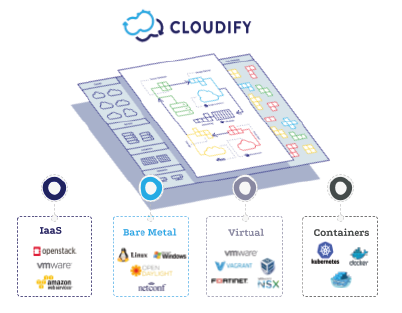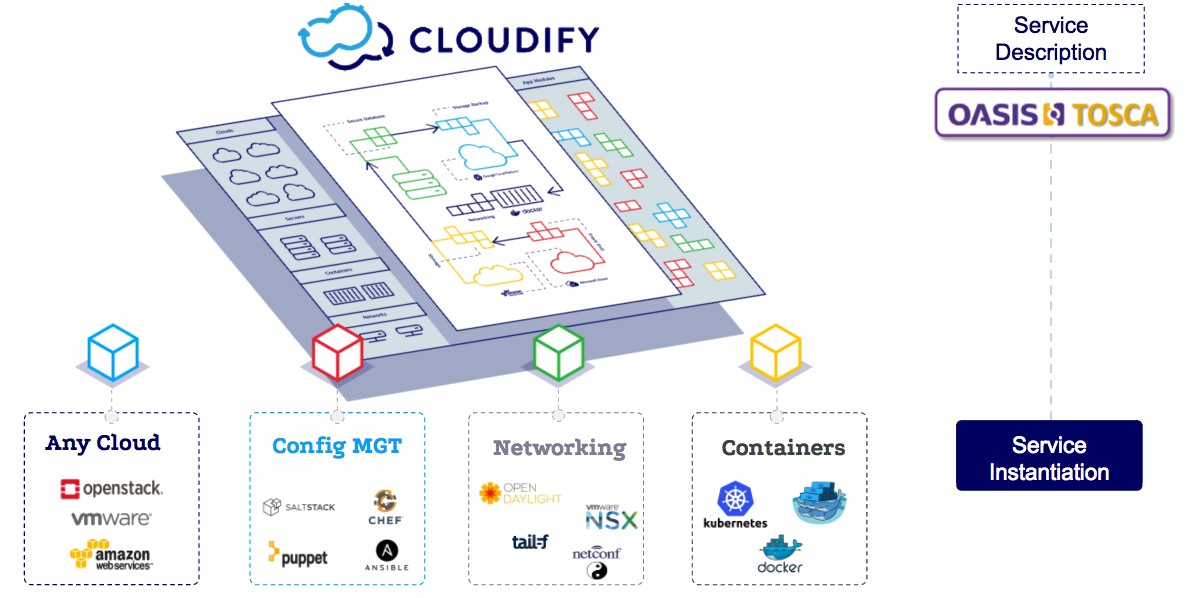A Guide To Cloudify Container Support For Kubernetes And Docker
Get the latest docs
You are looking at documentation for an older release. Not what you want? Go to the current release documentation.Cloudify supports integrations with Docker and Docker-based container managers, such as Kubernetes. When orchestrating container orchestrators, Cloudify focuses on the infrastructure layer, managing lifecycle events between the container and the non-container worlds.
Infrastructure Orchestration
Cloudify can be used to deploy, heal, scale, and tear down container clusters.
Cloudify can orchestrate bare metal, virtual platforms, such as Libvirt and Vsphere, and cloud platforms, such as AWS, Openstack, Azure, GCP, etc. This can include networking and storage infrastructure, both virtual and physical.

Cloudify Kubernetes Provider
Kubernetes manages IaaS-resource provisioning via Cloud Providers. The Cloudify Kubernetes Provider enables Kubernetes to use Cloudify as the Iaas. This enables a single cluster to span a number of topologies. For example a Kubernetes cluster may contain Nodes any number of various cabilities, including multiple clouds.
Requirements:
- Cloudify 4.2 or above.
- Environment secrets (credentials, required resource IDs).
- cloudify-kubernetes-plugin, version 1.3.1.
- cloudify-utilities-plugin, version 1.4.1.
- One of the following:
- cloudify-aws-plugin, version 1.5.1.2.
- cloudify-openstack-plugin, version 2.4.1.1.
- cloudify-azure-plugin, version 1.4.3.
- cloudify-gcp-plugin, version 1.1.0.
- cloudify-vsphere-plugin, version 2.3.0.
Setup:
If you have not already setup your Cloudify Manager, follow these instructions.
After that, create null secrets:
for i in kubernetes_master_ip \
kubernetes_certificate_authority_data \
kubernetes_master_port \
kubernetes-admin_client_key_data \
kubernetes-admin_client_certificate_data;
do cfy secrets create -s null $i;
done
The blueprint requires that these secrets are in place, even though they will be overwritten later.
Find the latest release of the Provider. Save the URL of the source code in zip format, as well as the URLs of the Cloudify Provider Binaries (cfy-kubernetes, and cfy-autoscale).
Download the zip source code:
wget https://github.com/cloudify-incubator/cloudify-kubernetes-provider/archive/0.0.0+13.zip
Unzip the zip archive of the source code:
unzip 0.0.0+13.zip
Download the Cloudify Kubernetes Provider Binaries to the examples/cluster_blueprint/resources directory:
wget https://github.com/cloudify-incubator/cloudify-kubernetes-provider/releases/download/0.0.0+13/cfy-kubernetes -O cloudify-kubernetes-provider-0.0.0-13/examples/cluster_blueprint/resources/cfy-kubernetes
wget https://github.com/cloudify-incubator/cloudify-kubernetes-provider/releases/download/0.0.0+13/cfy-autoscale -O cloudify-kubernetes-provider-0.0.0-13/examples/cluster_blueprint/resources/cfy-autoscale
Note that at this point, you are ready to deploy your cluster. Note that by default the number of Kubernetes Nodes to be deployed, in addition to the master Node, is 1. To change that, toggle the “kubernetes_node_vms_scaling_policy” default_instances in your IaaS blueprint.
Deploy the cluster:
cfy install cloudify-kubernetes-provider-0.0.0-13/examples/cluster_blueprint/openstack.yaml
Note that the cluster blueprint IaaS examples cover Vsphere, GCP, Azure, Openstack, and AWS. Get in touch to learn about support for other platforms.__
If these commands were successful, you can retreve your master IP by executing cfy secrets get kubernetes_master_ip.
Service Orchestration
Independently from the orchestration of infrastructure, Cloudify provides the ability to orchestrate heterogenous services across platforms. By leveraging the strength of TOSCA modeling, Cloudify can manage the instantiation and configuration of service chains, regardless of the target platform.

Cloudify Kubernetes Plugin
The Cloudify Kubernetes Plugin enables you to interact with the Kubernetes API through blueprints.
Kubernetes manifests can be packages with your blueprint via Cloudify node templates. Include the manifest file in a resources directory, or include the text of the manifest inline.
Examples:
Referencing a manifest file in a node template:
my_pod:
type: cloudify.kubernetes.resources.FileDefinedResource
properties:
file:
resource_path: resources/pod.yaml
relationships:
- type: cloudify.kubernetes.relationships.managed_by_master
target: kubernetes_master
Referencing multiple manifest files in one node template:
my_kubernetes_application:
type: cloudify.kubernetes.resources.MultipleFileDefinedResources
properties:
files:
- resource_path: resources/pod.yaml
- resource_path: resources/service.yaml
relationships:
- type: cloudify.kubernetes.relationships.managed_by_master
target: kubernetes_master
Using an inline manifest:
nginx_service:
type: cloudify.kubernetes.resources.Service
properties:
definition:
apiVersion: v1
kind: Service
metadata:
labels:
app: nginx
name: nginx
spec:
ports:
- port: { get_input: nginx_port }
selector:
app: nginx
tier: frontend
type: LoadBalancer
relationships:
- type: cloudify.kubernetes.relationships.managed_by_master
target: kubernetes_master
- type: cloudify.relationships.depends_on
target: nginx_deployment
Note: See the Kubernetes Plugin docs for more information on the plugin.
With the plugin, you can create Cloudify deployments that include both container and non-container resources:
aws_centos_vm:
type: cloudify.aws.nodes.Instance
properties:
image_id: { get_secret: centos_image_id }
instance_type: { get_secret: centos_instance_type }
name: { get_secret: centos_computer_name }
agent_config:
install_method: none
aws_config: *aws_config
relationships:
- type: cloudify.aws.relationships.connected_to_elastic_ip
target: kubeinstance_port_elastic_ip
kubernetes_app_service:
type: cloudify.kubernetes.resources.Service
properties:
definition:
apiVersion: v1
kind: Service
metadata:
labels:
app: hello-app
name: hello-app
spec:
ports:
- port: 80
selector:
app: hello-app
tier: frontend
type: LoadBalancer
relationships:
- type: cloudify.kubernetes.relationships.managed_by_master
target: kubernetes_master
For a detailed, demo of the above orchestration, contact us.
